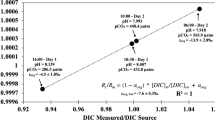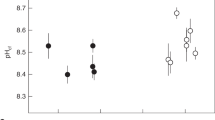Abstract
Tropical macroalgae serve importance ecological roles on coral reefs but can supplant corals in phase shifts as shown worldwide. Thus, it is important to understand their fundamental photophysiology and effects on calcification mechanisms. We examined organic δ13C, inorganic CaCO3 δ13C and δ18O, and organic %C, %N, C:N of abundant macroalgae on Little Cayman Island (LCI) reefs across a broad light gradient (5–2,000 μmol photons m−2 s−1). We hypothesized that LCI macroalgae utilize greater CO2 in low light environments as carbon concentration mechanisms (CCMs) to take up HCO3− have high energetic costs. We proposed that calcification mechanisms are also influenced by light and Ci-use strategies. LCI macroalgae had organic δ13C values (-12‰ to -25‰) indicative of CCMs and exhibited only a 1–3‰ δ13C depletion under irradiances < 5 μmol photons m−2 s−1. Light and phyla were significant in a mixed model explaining ~ 80% of variance in organic δ13C. Organic δ13C was a weak predictor and light insignificant in explaining inorganic δ13C values of thalli carbonates. Biogenic carbonate δ13C values were taxa-specific based on cluster analysis of δ13C:δd18O ratios, an indication of diverse calcification mechanisms. LCI macroalgal photosynthesis utilized CCMs across a broad range of irradiances, thus greater CO2 availability under ocean acidification is not likely to enhance community dominance of macroalgae of concern (e.g., Lobophora sp.) due to shifts in photophysiology. The mechanisms of Ci sequestration for photosynthesis appeared to be mostly uncoupled from calcification mechanisms that were diverse across phyla, likely due to distinct macroalgal forms, sites of calcification and carbonate structure.



Similar content being viewed by others
Data availability
The datasets generated during and/or analyzed during the current study are available from the corresponding author on reasonable request.
References
Adkins JF, Boyle EA, Curry WB, Lutringer A (2003) Stable isotopes in deep-sea corals and a new mechanism for “vital effects.” Geochim Cosmochim Acta 67:1129–1143
Basso D (2012) Carbonate production by calcareous red algae and global change. Geodiversitas 34:13–33
Beer S, Koch E (1996) Photosynthesis of marine macroalgae and seagrasses in globally changing CO2 environments. Mar Ecol Prog Ser 141:199–204
Bergstrom E, Ordonez A, Ho M, Hurd C, Fry B, Diaz-Pulido G (2020) Inorganic carbon uptake strategies in coralline algae: Plasticity across evolutionary lineages under ocean acidification and warming. Mar Environ Res 161:105107
Bianco-Stein N, Polishchuk I, Lang A, Portal L, Dejoie C, Katsman A, Pokroy B (2022) High-Mg calcite nanoparticles within a low-Mg calcite matrix: A widespread phenomenon in biomineralization. Proc Natl Acad Sci USA 119:e2120177119
Castro-Sanguino C, Bozec YM, Mumby PJ (2020) Dynamics of carbonate sediment production by Halimeda: implications for reef carbonate budgets. Mar Ecol Prog Ser 639:91–106
Chen S, Gagnon AC, Adkins JF (2018) Carbonic anhydrase, coral calcification and a new model of stable isotope vital effects. Geochim Cosmochim Acta 236:179–197
Chisholm JRM (2000) Calcification by crustose coralline algae on the northern Great Barrier Reef, Australia. Limnol Oceanogr 45:1476–1484
Cornwall CE, Revill AT, Hurd CL (2015) High prevalence of diffusive uptake of CO2 by macroalgae in a temperate subtidal ecosystem. Photosynth Res 124:181–190
Dell CLA, Longo GO, Burkepile DE, Manfrino C (2020) Few herbivore species consume dominant macroalgae on a Caribbean coral reef. Front Mar Sci 7:676
Diaz-Pulido G, Cornwall C, Gartrell P, Hurd C, Tran DV (2016) Strategies of dissolved inorganic carbon use in macroalgae across a gradient of terrestrial influence: implications for the Great Barrier Reef in the context of ocean acidification. Coral Reefs 35:1327–1341
Fong P, Paul VJ (2011) Coral reef algae. In: Dubinsky Z, Stambler N (eds) Coral Reefs: An Ecosystem in Transition. Springer, Dordrecht, pp 241–272
Fulton CJ, Abesamis RA, Berkström C, Depczynski M, Graham NAJ, Holmes TH, Kulbicki M, Noble MM, Radford BT, Tano S, Tinkler P, Wernberg T, Wilson SK, Fox C (2019) Form and function of tropical macroalgal reefs in the Anthropocene. Funct Ecol 33:989–999
Fulton CJ, Berkström C, Wilson SK, Abesamis RA, Bradley M, Åkerlund C, Barrett LT, Bucol AA, Chacin DH, Chong-Seng KM, Coker DJ, Depczynski M, Eggertsen L, Eggertsen M, Ellis D, Evans RD, Graham NAJ, Hoey AS, Holmes TH, Kulbicki M, Leung PTY, Lam PKS, Lier J, Matis PA, Noble MM, Pérez-Matus A, Piggott C, Radford BT, Tano S, Tinkler P (2020) Macroalgal meadow habitats support fish and fisheries in diverse tropical seascapes. Fish Fish 21:700–717
Geyman EC, Maloof AC (2019) A diurnal carbon engine explains 13C-enriched carbonates without increasing the global production of oxygen. Proc Natl Acad Sci USA 116:24433–24439
Giordano M, Beardall J, Raven JA (2005) CO2 concentrating mechanisms in algae: Mechanisms, environmental modulation, and evolution. Annu Rev Plant Biol 56:99–131
Gomez-Lemos LA, Doropoulos C, Bayraktarov E, Diaz-Pulido G (2018) Coralline algal metabolites induce settlement and mediate the inductive effect of epiphytic microbes on coral larvae. Sci Rep 8:17557
Hay M (1988) Marine plant-herbivore interactions: The ecology of chemical defense. Annu Rev Ecol Syst 19:111–145
Hay ME (1997) The ecology and evolution of seaweed-herbivore interactions on coral reefs. Coral Reefs 16:S67–S76
Hepburn CD, Pritchard DW, Cornwall CE, McLeod RJ, Beardall J, Raven JA, Hurd CL (2011) Diversity of carbon use strategies in a kelp forest community: Implications for a high CO2 ocean. Glob Change Biol 17:2488–2497
Hofmann LC, Heesch S (2018) Latitudinal trends in stable isotope signatures and carbon-concentrating mechanisms of northeast Atlantic rhodoliths. Biogeosciences 15:6139–6149
Hughes TP, Rodrigues MJ, Bellwood DR, Ceccarelli D, Hoegh-Guldberg O, McCook L, Moltschaniwskyj N, Pratchett MS, Steneck RS, Willis B (2007) Phase shifts, herbivory, and the resilience of coral reefs to climate change. Curr Biol 17:360–365
Kerkar V (1994) Mineralogical studies on calcareous algae. Curr Sci 66:381–382
Koch M, Bowes G, Ross C, Zhang XH (2013) Climate change and ocean acidification effects on seagrasses and marine macroalgae. Glob Change Biol 19:103-132
Lee D, Carpenter SJ (2001) Isotopic disequilibrium in marine calcareous algae. Chem Geol 172:307–329
Littler DS, Littler MM (2000) Caribbean Reef Plants. Offshore Graphics Inc, Washington, DC
Littler MM, Littler DC (1984) Models of tropical reef biogenesis: The contribution of algae. Progr Phycol Res 3:323–364
Lovelock CE, Reef R, Raven JA, Pandolfi JM (2020) Regional variation in δ13C of coral reef macroalgae. Limnol Oceanogr 65:2291–2302
Maberly SC, Raven JA, Johnston AM (1992) Discrimination between 12C and 13C by marine plants. Oecologia 91:481–492
Maberly SC, Stott AW, Gontero B (2022) The differential ability of two species of seagrass to use carbon dioxide and bicarbonate and their modelled response to rising concentrations of inorganic carbon. Front Plant Sci 13:936716
Manfrino C, Jacoby CA, Camp E, Frazer TK (2013) A positive trajectory for corals at Little Cayman Island. PLoS One 8:e75432
McConnaughey T (1989) 13C and 18O isotopic disequilibrium in biological carbonates: I. Patterns. Geochim Cosmochim Acta 53:151–162
McConnaughey TA (2003) Sub-equilibrium oxygen-18 and carbon-13 levels in biological carbonates: carbonate and kinetic models. Coral Reefs 22:316–327
McManus JW, Polsenberg JF (2004) Coral–algal phase shifts on coral reefs: Ecological and environmental aspects. Progr Oceanogr 60:263–279
Raven JA, Beardall J, Giordano M (2014) Energy costs of carbon dioxide concentrating mechanisms in aquatic organisms. Photosynth Res 121:111–124
Raven JA, Johnston AM, Kübler JE, Korb R, McInroy SG, Handley LL, Scrimgeour CM, Walker DI, Beardall J, Vanderklift M, Fredriksen S, Dunton KH (2002) Mechanistic interpretation of carbon isotope discrimination by marine macroalgae and seagrasses. Funct Plant Biol 29:355–378
Spadaro AJ, Butler MJ (2021) Herbivorous crabs reverse the seaweed dilemma on coral reefs. Curr Biol 31:853–859 e853
Stepien CC (2015) Impacts of geography, taxonomy and functional group on inorganic carbon use patterns in marine macrophytes. J Ecol 103:1372–1383
Velázquez-Ochoa R, Ochoa-Izaguirre MJ, Soto-Jiménez MF (2022) An analysis of the variability in δ13C in macroalgae from the Gulf of California: indicative of carbon concentration mechanisms and isotope discrimination during carbon assimilation. Biogeosciences 19:1–27
Vieira C (2019) Lobophora–coral interactions and phase shifts: summary of current knowledge and future directions. Aquat Ecol 54:1–20
Vieira C, Morrow K, D’Hondt S, Camacho O, Engelen AH, Payri CE, De Clerck O (2020) Diversity, ecology, biogeography, and evolution of the prevalent brown algal genus Lobophora in the Greater Caribbean Sea, including the description of five new species. J Phycol 56:592–607
Whitman TN, Negri AP, Bourne DG, Randall CJ (2020) Settlement of larvae from four families of corals in response to a crustose coralline alga and its biochemical morphogens. Sci Rep 10:16397
Wilson SK, Fulton CJ, Graham NAJ, A. Abesamis R, Berkström C, Coker DJ, Depczynski M, Evans RD, Fisher R, Goetze J, Hoey A, Holmes TH, Kulbicki M, Noble M, Robinson James PW, Bradley M, Åkerlund C, Barrett LT, Bucol AA, Birt MJ, Chacin DH, Chong‐Seng KM, Eggertsen L, Eggertsen M, Ellis D, Leung PTY, Lam PKS, van Lier J, Matis PA, Pérez‐Matus A, Piggott CVH, Radford BT, Tano S, Tinkler P (2022) The contribution of macroalgae‐associated fishes to small‐scale tropical reef fisheries. Fish Fish 23:847-861
Zaiontz C (2022) Real Statistics support for k-means cluster analysis. Excel. https://real-statistics.com/multivariate-statistics/cluster-analysis/real-statistics-k-means/
Zweng RC, Koch MS, Bowes G (2018) The role of irradiance and C-use strategies in tropical macroalgae photosynthetic response to ocean acidification. Sci Rep 8:9479
Acknowledgements
Graduate (Regina Zweng) and undergraduate (Steven Olayon) students are thanked for their efforts in collecting/processing samples in the FAU lab and Cayman Island Marine Conservation Board and Department of the Environment for permitting our LCI research. We thank captain Jon Clamp for field support and the staff at LCI for assistance working at the Central Caribbean Research Station. Two anonymous reviewers and discussions with Peter Swart significantly improved the manuscript, and we are grateful for their time and effort.
Funding
This research was funded by the National Science Foundation Ocean Acidification Program-CRI-OA Grant #1416376.
Author information
Authors and Affiliations
Contributions
All authors assisted in data collection, reviewing the manuscript.
Conall McNicholl—processed samples.
Carrie Manfrino—coordinated field collection at LCI.
Brian Lapointe—analyzed nutrient samples.
Marguerite Koch—coordinated the project, developed hypotheses, and wrote the manuscript.
Corresponding author
Ethics declarations
Competing interests
The authors have no competing interests.
Additional information
Publisher's Note
Springer Nature remains neutral with regard to jurisdictional claims in published maps and institutional affiliations.
Rights and permissions
Springer Nature or its licensor (e.g. a society or other partner) holds exclusive rights to this article under a publishing agreement with the author(s) or other rightsholder(s); author self-archiving of the accepted manuscript version of this article is solely governed by the terms of such publishing agreement and applicable law.
About this article
Cite this article
Koch, M.S., McNicholl, C., Manfrino, C. et al. Stable carbon and oxygen isotopes indicate photophysiology and calcification mechanisms of macroalgae on Little Cayman Island reefs. J Appl Phycol 36, 1023–1033 (2024). https://doi.org/10.1007/s10811-023-03079-9
Received:
Revised:
Accepted:
Published:
Issue Date:
DOI: https://doi.org/10.1007/s10811-023-03079-9




